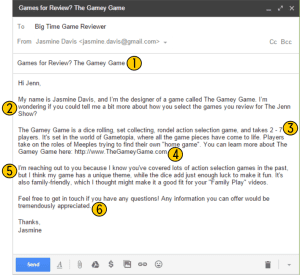
When I’m not writing for the Internet, I’m a professional Internet writer. (I just can’t get away.) Part of my everyday job involves doing outreach for my clients, trying to help them get reviews for their products. Since I do this every day, I’ve learned a thing or two about an initial approach that doesn’t take forever and can get good results.
The key to a good review request is to be polite, brief, and inquisitive.
HERE’S A BREAKDOWN OF A TYPICAL EMAIL I’D SEND:

1. INCLUDE YOUR GAME TITLE IN THE SUBJECT LINE.
Anybody who reviews anything online gets tons of requests every day, and putting your game name in the subject header gives them a way to find you.
2. PHRASE IT AS A QUESTION.
Instead of asking a reviewer if they’d take a look at your game, ask what they’re looking for when they select games. This does a couple of things for you. First of all, if they’re absolutely not accepting reviews, or they only do paid reviews, or they’re totally booked for the rest of the year, you’ll find out right away (and have more knowledge for the next time you need to reach out). Second, this establishes up front that you’re going to be polite and easy to work with (because you are, aren’t you?).
3. IT’S AN ELEVATOR PITCH, NOT A “TRAPPED IN THE ELEVATOR” PITCH.
If you were pitching in person, you’d get about 30 seconds to introduce your game, talk about its mechanics, and say what sets it apart. In an email, you have three sentences – about five lines – before it becomes a block of text. Don’t worry about explaining the minutae of gameplay. If a reviewer is interested, they’ll ask for more.
4. DON’T HYPERLINK.
It goes against everything in my Internet-loving heart to not hyperlink, but when it comes to a first approach, people can be suspicious of unknown links. When you put a plaintext link to your site, you’re showing exactly where it goes. Honesty all around. If you have a long URL, consider sending them to your Twitter account, or to the main site instead. Shortening links via bit.ly runs into the same problem that a hyperlink does.
5. EXPLAIN YOURSELF!
Not every game designer follows every game reviewer religiously, I know. But taking the time to add some “why” to your pitch and explain how your game specifically fits their blog or show. If you know they regularly review family games, and you’ve got one, point it out. If you see that they haven’t reviewed a specific type of game that much, explain why you think yours is a good fit anyway.
6. MAKE IT A POLITENESS SANDWICH.
End with a nice call to action and thank them in advance for their help. Lots of reviewers do this as a public service, and even those that don’t spend a ton of time wading through emails.
As with anything, your mileage may vary – different reviewers have different opinions and preferences. But I’ve found that a polite approach, where you ask questions rather than assume they’ll cover you, goes a long way regardless of industry. I also wrote about this a bit more on my own blog, if you’re so inclined.








